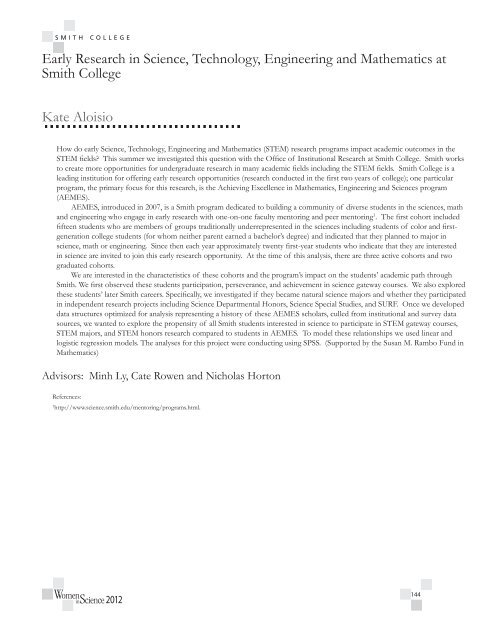Brugia Malayi - Clark Science Center - Smith College
Brugia Malayi - Clark Science Center - Smith College
Brugia Malayi - Clark Science Center - Smith College
You also want an ePaper? Increase the reach of your titles
YUMPU automatically turns print PDFs into web optimized ePapers that Google loves.
Early Research in <strong>Science</strong>, Technology, Engineering and Mathematics at<br />
<strong>Smith</strong> <strong>College</strong><br />
Kate Aloisio<br />
How do early <strong>Science</strong>, Technology, Engineering and Mathematics (STEM) research programs impact academic outcomes in the<br />
STEM fields? This summer we investigated this question with the Office of Institutional Research at <strong>Smith</strong> <strong>College</strong>. <strong>Smith</strong> works<br />
to create more opportunities for undergraduate research in many academic fields including the STEM fields. <strong>Smith</strong> <strong>College</strong> is a<br />
leading institution for offering early research opportunities (research conducted in the first two years of college); one particular<br />
program, the primary focus for this research, is the Achieving Excellence in Mathematics, Engineering and <strong>Science</strong>s program<br />
(AEMES).<br />
AEMES, introduced in 2007, is a <strong>Smith</strong> program dedicated to building a community of diverse students in the sciences, math<br />
and engineering who engage in early research with one-on-one faculty mentoring and peer mentoring 1 . The first cohort included<br />
fifteen students who are members of groups traditionally underrepresented in the sciences including students of color and firstgeneration<br />
college students (for whom neither parent earned a bachelor’s degree) and indicated that they planned to major in<br />
science, math or engineering. Since then each year approximately twenty first-year students who indicate that they are interested<br />
in science are invited to join this early research opportunity. At the time of this analysis, there are three active cohorts and two<br />
graduated cohorts.<br />
We are interested in the characteristics of these cohorts and the program’s impact on the students’ academic path through<br />
<strong>Smith</strong>. We first observed these students participation, perseverance, and achievement in science gateway courses. We also explored<br />
these students’ later <strong>Smith</strong> careers. Specifically, we investigated if they became natural science majors and whether they participated<br />
in independent research projects including <strong>Science</strong> Departmental Honors, <strong>Science</strong> Special Studies, and SURF. Once we developed<br />
data structures optimized for analysis representing a history of these AEMES scholars, culled from institutional and survey data<br />
sources, we wanted to explore the propensity of all <strong>Smith</strong> students interested in science to participate in STEM gateway courses,<br />
STEM majors, and STEM honors research compared to students in AEMES. To model these relationships we used linear and<br />
logistic regression models. The analyses for this project were conducting using SPSS. (Supported by the Susan M. Rambo Fund in<br />
Mathematics)<br />
Advisors: Minh Ly, Cate Rowen and Nicholas Horton<br />
References:<br />
1<br />
http://www.science.smith.edu/mentoring/programs.html.<br />
2012<br />
144

















